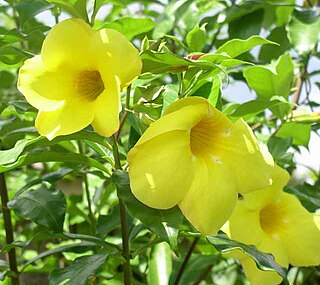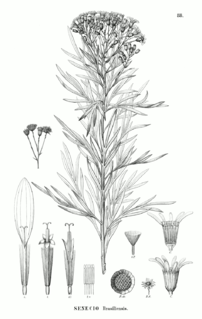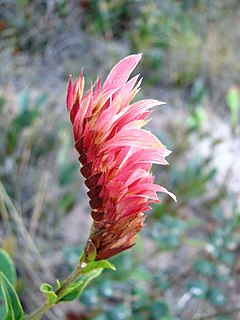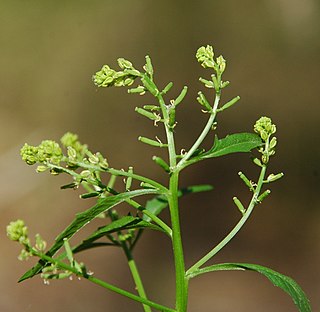
Allamanda cathartica, commonly called golden trumpet, common trumpetvine, and yellow allamanda, is a species of flowering plant of the genus Allamanda in the family Apocynaceae. It is native to Brazil. This plant is cited in Flora Brasiliensis by Carl Friedrich Philipp von Martius.
Savia is a genus of the family Phyllanthaceae first described as a genus in 1806. It is native to the West Indies, the Florida Keys, Mexico, Venezuela, Brazil, and Paraguay.
- Savia dictyocarpaMüll.Arg. - Paraguay, S Brazil
- Savia sessiliflora(Sw.) Willd. - Mexico, West Indies, Venezuela

Symphonia is a genus of tropical woody plants, specifically trees in the family Clusiaceae. The genus has its diversity center in Madagascar and one species disjunct in the Afrotropic and the Neotropic in the Amazon Rainforest.

August Wilhelm Eichler, also known under his Latinized name, Augustus Guilielmus Eichler, was a German botanist who developed a new system of classification of plants to reflect the concept of evolution. His author abbreviation in botany is Eichler.

Flora Brasiliensis is a book published between 1840 and 1906 by the editors Carl Friedrich Philipp von Martius, August Wilhelm Eichler, Ignatz Urban and many others. It contains taxonomic treatments of 22,767 species, mostly Brazilian angiosperms.
Ruellia verbasciformis is a plant native to the Cerrado vegetation of Brazil. This plant is cited in Flora Brasiliensis by Carl Friedrich Philipp von Martius.
Hygrophila costata, with the common names glush weed, gulf swampweed, and yerba de hicotea, is an aquatic plant

Lophostachys floribunda is a plant native to the Caatinga and Cerrado vegetation of Brazil. This plant is cited in Flora Brasiliensis by Carl Friedrich Philipp von Martius.
Lophostachys laxiflora is a plant native to the Cerrado vegetation of Brazil. This plant is cited in Flora Brasiliensis by Carl Friedrich Philipp von Martius.
Lophostachys falcata is a plant native to the Cerrado vegetation of Brazil. This plant is cited in Flora Brasiliensis by Carl Friedrich Philipp von Martius.
Lophostachys montana is a plant native to the Cerrado vegetation of Brazil. This plant is cited in Flora Brasiliensis by Carl Friedrich Philipp von Martius. The Latin specific epithet montana refers to mountains or coming from mountains.
Lophostachys villosa is a plant native to the Cerrado vegetation of Brazil. This plant is cited in Flora Brasiliensis by Carl Friedrich Philipp von Martius.
Stenandrium pohlii, with Portuguese common names caiapiá or carapiá, is a plant native to Cerrado and Pantanal vegetation of Brazil. The description of the plant was published in Flora Brasiliensis in 1847.
Lophostachys is a genus of plants in the family Acanthaceae.

Anemopaegma glaucum is a plant native to Caatinga and Cerrado vegetation in Brazil. This plant is cited in Flora Brasiliensis by Carl Friedrich Philipp von Martius.

Heterotheca sessiliflora is a species of flowering plant in the daisy family known by the common name sessileflower false goldenaster. It is native to California, Sonora, and Baja California.

Barbacenia is a plant genus in the family Velloziaceae, described as a genus in 1788. The entire genus is endemic to Brazil with the exception of B. celiae, which crosses the border into Venezuela.

Rorippa sessiliflora, commonly known as stalkless yellowcress, is a species of flowering plant in the family Brassicaceae.

Medicosma sessiliflora is a species of shrub or small tree in the family Rutaceae and is endemic to far north Queensland. It has simple elliptical to egg-shaped leaves with the narrower end towards the base and cream-coloured flowers borne singly or in small groups in leaf axils.
This page is based on this
Wikipedia article Text is available under the
CC BY-SA 4.0 license; additional terms may apply.
Images, videos and audio are available under their respective licenses.









